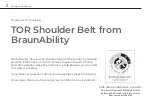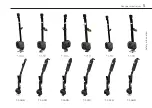
14
Occupant restraints
1.
The rail will have been installed in the vehicle in accordance with our own and the vehicle
converter’s instruction. Position the wheelchair within the vehicle as required.
2.
Wheelchair tie-downs and occupant lap belt should be fitted before the shoulder belt
3.
Fit the shoulder belt ATF (aluminium track fitting) into the rail by aligning the ATF feet
with the cut-out section of the rail, (Fig. 6A, the inertia reel should be mounted at an
angle of 90/90°).
4.
Press on the ribbed part of the ATF (Fig. 2A), push firmly in the direction of the rail until
the yellow plunger drops and locks into the rail. (T-bolts will have been fitted to 40Nm).
5.
Position the third point ATF fixing into the cant rail, (Fig. 6B), so that it is vertically above
the inertia reel casing fixed onto the floor fixing, as per point 4.
6. Once installed check the free running of the webbing into, and out of, the inertia reel
and check the ’lock up’ facility of the reel by engaging a short tub tug at various intervals
along the extension and retraction of the webbing in and out of the reel.
7. Draw the shoulder belt buckle, (Fig. 6C), across the upper body and attach to the lap belt
tongue, (Fig. 3A & 4A), to complete the 3 point belt system.
8. Adjust the tensioner, (Fig. 6D) so that it sits just above the occupant’s shoulder.
Removing the TOR
Shoulder Belt
1.
Unfasten the buckle
from the occupant’s
hips, remove the
shoulder belt restraint
and let the webbing
retract back into the
housing.
Fit and use
TOR Adjustable Shoulder Belt occupant restraint
Rail








































